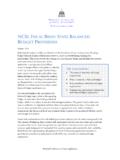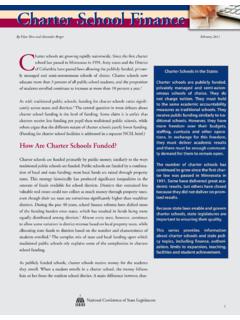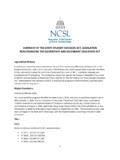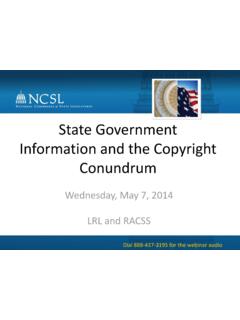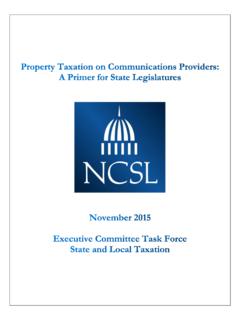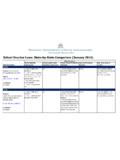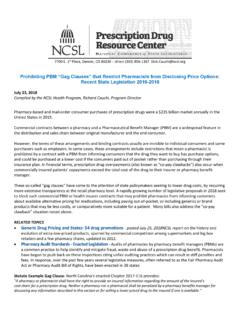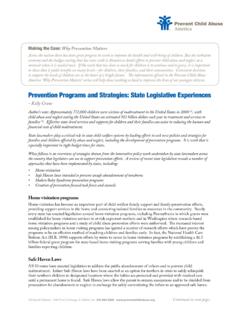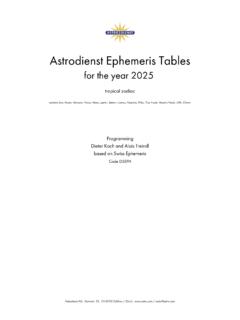Transcription of U.S. Population Trends: 2000 to 2060
1 Population trends : 2000 to 2060 Stephanie EwertPopulation DivisionNCSL Fiscal Analysts SeminarOctober 15, 2015 Overview trends in Population growth, aging, and diversity 2000 to 2010 2013 to : 2000 to 2010 Note: Data for 2000 and 2010 reflect censuscounts as of April 1. Data for all other years are for July : Census Bureau, 2000 to 2010 Intercensal Population Population increased by million, or percent, between 2000 and 55 to 1718 to 2425 to 4445 to 6465 and by Age Group: 2000 and 2010(Numbers in millions)Source: Census Bureau, 2000 and 2010 55 to 1718 to 2425 to 4445 to 6465 and overPercent Change in by Age Group: 2000 to 2010 Source: Census Bureau, 2000 and 2010 55 to 1718 to 2425 to 4445 to 6465 and over20002010 Distribution of the by Age Group: 2000 and 2010(Percent of total Population )Source: Census Bureau, 2000 and 2010 alone, Not Hispanic( )Black alone, Not Hispanic( )American Indian and Alaska Native alone, Not Hispanic ( )Native Hawaiian and Other Pacific Islander alone, Not Hispanic ( )Asian alone, Not Hispanic ( )Some Other Race alone,Not Hispanic ( )Two or More Races,Not Hispanic ( )Hispanic or Latino(of any race) ( )Minority Population ( )Note: Minority refers to people who reported their ethnicity and race as something other than non-Hispanic White alone in the 2010 : 2010 Census2010 Census Race, Hispanic Origin, Minority Distribution.
2 All alone, Not Hispanic( )Black alone, Not Hispanic( )American Indian and Alaska Native alone, Not Hispanic ( )Native Hawaiian and Other Pacific Islander alone,Not Hispanic ( )Asian alone, Not Hispanic ( )Some Other Race alone,Not Hispanic ( )Two or More Races,Not Hispanic ( )Hispanic or Latino(of any race) ( )Minority Population ( )2010 Census Race, Hispanic Origin, Minority Distribution: Population Under Age 18 Note: Minority refers to people who reported their ethnicity and race as something other than non-Hispanic White alone in the 2010 : 2010 Census910 West ,Not Hispanic(+ )Blackalone,Not Hispanic(+ )AmericanIndianandAlaska Nativealone,Not Hispanic(+ )NativeHawaiianand OtherPacific Islanderalone,Not Hispanic(+ )Asianalone,NotHispanic(+ )SomeOtherRacealone,Not Hispanic(+ )TotalPopulation(+ )Two orMoreRaces,Not Hispanic(+ )Hispanicor Latino(of any race)(+ )MinorityPopulation(+ )Source: 2010 Censusand Census 2000 Note: Minority refers to people who reportedtheir ethnicity and race as something other thannon-Hispanic White alone in the 2010 Change 2000 to 2010.
3 All ,NotHispanic( )Blackalone,NotHispanic( )AmericanIndianandAlaska Nativealone,Not Hispanic( )NativeHawaiianand OtherPacific Islanderalone,Not Hispanic(+ )Asianalone,NotHispanic(+ )SomeOtherRacealone,Not Hispanic(+ )TotalPopulation(+ )Two orMoreRaces,Not Hispanic(+ )Hispanicor Latino(of any race)(+ )MinorityPopulation(+ )Source: 2010 Censusand Census 2000 Note: Minority refers to people who reportedtheir ethnicity and race as something other thannon-Hispanic White alone in the 2010 Change 2000 to 2010: Population Under Age 18171819202122 Future Trends2324 Light blue columns represent Population estimates for StatesPopulation: 1990 to 2060 The Population is projected to increase from 316 million in 2013 to 420 million in 2060,reaching 400 million in (in millions)251087651538301052000-20102010- 20202020-20302030-20402040-2050 Total population65 and overPercent Change in Population Size by Decade: 2000 -2010to 2040-20502621222334353624232621201420502 0302012 Under 1818 to 4445 to 6465 and overDistribution of the Population by Age Group: 1965 to 2050274356738084141720212120122020203020 402050 Population aged 65 years and over (in millions)Percent of total populationPopulation Aged 65 and Over: 2012 to 20502845535634353121121420502030201265 to 7475 to 8485 and overDistribution of the Older Population by Age Group: 2012 to 2050290102030405060708090100201020202030 204020502060 Millions Under 18 years 65 years and overPopulation Under 18 Years and 65 Years and Over.
4 2010 to 2060 Population (in millions)The Population 65 years and over is projected to become larger than the Population under 18years in DependencyOld-Age DependencyTotal dependency = (( Population under age 18 + Population aged 65 years and over) / ( Population aged 18 to 64 years)) * 100. Old-age dependency = ( Population aged 65 years and over / Population aged 18 to 64 years) * 100. Youth dependency = ( Population under age 18 / Population aged 18 to 64 years) * 100. Dependency Ratios for the United States: 1990 to (of any race)Two orMore Races,Not HispanicNHPI alone,Not HispanicAsian alone,Not HispanicAIAN alone,Not HispanicBlack alone,Not HispanicWhite alone,Not HispanicTotalPercent Change in Population by Race and Hispanic Origin: 2013 to 2060 AIAN=AmericanIndian and Alaska Native; NHPI=Native Hawaiian and Other Pacific (of any race)Two orMore Races,Not HispanicNHPI alone,Not HispanicAsian alone,Not HispanicAIAN alone,Not HispanicBlack alone,Not HispanicWhite alone,Not Hispanic20132060 Population by Race and Hispanic Origin: 2013 and 2060(Percent of total Population )AIAN=AmericanIndian and Alaska Native.
5 NHPI=Native Hawaiian and Other Pacific (of any race)Two orMore Races,Not HispanicNHPI alone,Not HispanicAsian alone,Not HispanicAIAN alone,Not HispanicBlack alone,Not HispanicWhite alone,Not HispanicTotalPercent Change in the Population Under 18 Years by Race and Hispanic Origin: 2013 to 2060 AIAN=AmericanIndian and Alaska Native; NHPI=Native Hawaiian and Other Pacific (of any race)Two orMore Races,Not HispanicNHPI alone,Not HispanicAsian alone,Not HispanicAIAN alone,Not HispanicBlack alone,Not HispanicWhite alone,Not Hispanic20132060 Population Under 18 Years by Race and Hispanic Origin: 2013 and 2060(Percent of total Population under 18 years)AIAN=AmericanIndian and Alaska Native; NHPI=Native Hawaiian and Other Pacific 18 yearsPercent Minority: 2013to 2060 Minority refers to everyone other than the non-Hispanic White alone : 2000 to 2010 In 2010, just over one-third of the Population reported their race as something other than non-Hispanic White alone.
6 Nearly half of the Population under 18 years are something other than non-Hispanic White alone. Of the million people added to the Population between 2000 and 2010, million were Hispanic or a race other than : 2013 to 2060 The Population is projected to grow more slowly. The older Population is projected to nearly double, growing from 43 million in 2012 to 84 million in 2050. By 2030, one in five Americans will be 65 years or older. The United States is projected to become a plurality nation by 2043. In 2060, percent of the total Population and percent of the Population under 18is expected to be InformationStephanie EwertForeign-Born Population
